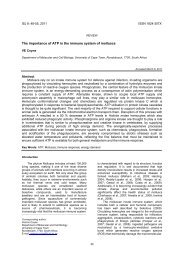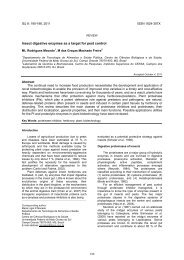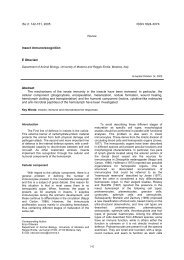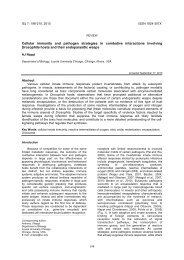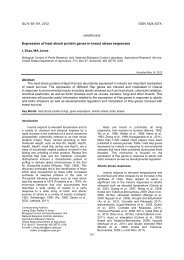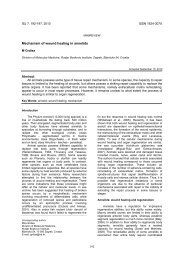Parasite-host relationship: a lesson from a professional killer
Parasite-host relationship: a lesson from a professional killer
Parasite-host relationship: a lesson from a professional killer
You also want an ePaper? Increase the reach of your titles
YUMPU automatically turns print PDFs into web optimized ePapers that Google loves.
In 1987 Dunphy and Webster presented<br />
preliminary evidences in favor of a possible role for<br />
the epicuticle layer of S. feltiae in cellular immunodepression.<br />
The paper pointed out interactions of the<br />
body surface of the entomopathogen with G.<br />
mellonella hemocytes and suggested its involvement<br />
in avoiding cellular encapsulation. The authors<br />
described a partial characterization of cuticle sugars<br />
by means of lectin specificity but, more interestingly,<br />
they assessed the role of the lipidic moiety of the<br />
epicuticle of S. feltiae. A simple assay based on lipase<br />
treatments determined that surface lipids played a role<br />
in escaping <strong>from</strong> hemocytes recognition; on this basis,<br />
they supposed that modifications of the lipidic surface<br />
resulted in a changed molecular architecture of the<br />
epicuticle, thus exposing discriminable antigens.<br />
Primarily inspired by these suggestions, we have<br />
focused the research on the role of S. feltiae cuticle,<br />
with the aim to exclude any contribution <strong>from</strong><br />
symbiontic bacteria and/or active secretions of the<br />
parasite. Our preliminary observations (Brivio et al.,<br />
2002) showed <strong>host</strong> proPO system inhibition in G.<br />
mellonella larvae infected with heat-killed<br />
nematocomplexes; although these results suggested<br />
that factors released <strong>from</strong> the parasite were not<br />
responsible of proPO inhibition, they did not<br />
completely exclude the involvement of bacteria.<br />
However, these data supported the attractive<br />
hypothesis that the parasite, after entry into the <strong>host</strong><br />
hemocoel, exploits its body-surface to immunoevade<br />
and/or immunodepress <strong>host</strong> defenses. A strong<br />
confirmation of the above hypothesis came <strong>from</strong> the<br />
assays carried out with isolated cuticles. The<br />
suppression of the hemolymph phenoloxidase activity,<br />
observed after either in vivo cuticle injection or in vitro<br />
co-incubation (cuticles plus cell-free hemolymph), was<br />
comparable to that obtained in the experiments<br />
performed with killed whole parasites.<br />
The integrity of the molecular architecture of the<br />
cuticle seems to be essential to retain its<br />
immunodepressive properties, since chemical<br />
alterations of the structure result in a marked loss of<br />
inhibition of the <strong>host</strong> proPO system. Moreover,<br />
confirming Dunphy’s suggestions, the main effect was<br />
observable after damage or removal of the lipidic layer<br />
obtained with lipase and methanol-chloroform<br />
treatments (Fig. 5).<br />
These data confirmed the first assumption of a<br />
key role of the lipids in the <strong>host</strong>-parasite interaction,<br />
although no information concerning the mechanisms<br />
by which cuticular lipids may affect the activation of<br />
the proPO system was provided (Brivio et al., 2004).<br />
The process by means of which S. feltiae cuticle<br />
lipids showed inhibitory effects on the <strong>host</strong> proPO<br />
system was further investigated hypothesizing that<br />
these molecules might interact with hemolymph factor<br />
involved in the activation pathway of <strong>host</strong><br />
phenoloxidase. A set of experiments based on in vitro<br />
interaction of purified parasite cuticle with cell-free<br />
<strong>host</strong> hemolymph (Fig. 6), demonstrated a specific<br />
binding property of the cuticle: particularly, the lipidic<br />
moiety interacts and sequesters three hemolymph<br />
proteins (17, 26, 35 kD), named HIPs (Host-<br />
Interacting Proteins), possibly involved in the proPO<br />
activation cascade.<br />
Concerning the identity and functions of HIPs, on<br />
the basis of preliminary characterization based on<br />
47<br />
molecular mass and according to the literature<br />
(Dettloff et al., 2001), we supposed that, firstly, the 17<br />
kD HIP could be identified as the insect lipid-carrier<br />
Apolipophorin III. Besides reports on its well-known<br />
functions in the lipid metabolism (Ryan and Van der<br />
Horst, 2000), exhaustive studies have been carried out<br />
on the involvement of this protein in immunological<br />
responses (Wiesner et al., 1997; Halwani and Dunphy,<br />
1999; Zakarian et al., 2002). HIP26 has a molecular<br />
weight comparable to that of LBP-2 (a<br />
lipopolysaccharide-binding protein) described by<br />
Dunphy and Halwani (1997) in G. mellonella. This<br />
protein shows a specific affinity for endotoxin lipid-A<br />
and seems to be involved both in hemocytes activation<br />
and proPO system regulation. The third factor of 35 kD<br />
has a molecular weight similar to the protease-like<br />
molecule scolexin. Insect scolexin is well<br />
characterized at molecular level, although its biological<br />
function is not yet understood (Finnerty et al., 1999).<br />
The significant quantitative reduction of HIPs<br />
induced by the parasite is responsible for the blockage<br />
of the activation pathway of the proPO system; when<br />
these components, eluted <strong>from</strong> the parasite body<br />
surface, are added during in vitro assays, the normal<br />
hemolymph phenoloxidase activity of the <strong>host</strong> is<br />
restored. Furthermore, a function of the HIPs seems to<br />
be related to the activation of hemolymph serine<br />
proteases, given that their properties of reactivation<br />
(Fig. 7) are lost if they are assayed in the presence of<br />
protease inhibitors.<br />
The precise reactivation mechanism of the proPO<br />
system mediated by HIPs still has to be determined; to<br />
this goal we carried out Far Western blot experiments<br />
by which these proteins showed LPS-binding<br />
properties (Fig. 8). This affinity has been confirmed by<br />
their ability to bind to the wall of Gram(-) bacteria (Fig.<br />
6, panel C, lane B).<br />
In addition, cuticle lipids seem to cross-react with<br />
anti-LPS antibodies suggesting a structural correlation<br />
between the parasite lipids and the bacterial LPS lipid-<br />
A domain (Fig. 9).<br />
An intriguing hypothesis could be that surface<br />
lipids may act as pathogen-associated molecular<br />
patterns-like (PAMPs-like) but, in this case, their<br />
interaction with the <strong>host</strong> HIPs (comparable to PRRs)<br />
would result in the removal of the latter <strong>from</strong> the insect<br />
hemolymph, thus preventing the activation of<br />
hemolymph serine proteases required for proPO<br />
activation and melanotic encapsulation.<br />
The interference of the parasite with cell-mediated<br />
defenses of the <strong>host</strong> was investigated by Ribeiro and<br />
co-workers (1999). The observed hemocyte damages<br />
were suggested to be related to factors released in the<br />
medium <strong>from</strong> nematocomplexes; these compounds<br />
(not identified) showed unsticking and cytotoxic effects<br />
on G. mellonella and M. unipunctata<br />
immunocompetent cells. The data presented seem to<br />
indicate an active interference process carried up by<br />
S. carpocapsae.<br />
Moreover, the interaction between the parasite<br />
body-surface molecules and <strong>host</strong> hemolymph<br />
components could result in a coating effect of the<br />
nematode. This coat, composed of <strong>host</strong> self-proteins,<br />
could induce molecular disguise processes. To<br />
ascertain the above assumption we have performed<br />
various assays clearly showing that Galleria<br />
hemocytes are unable to recognize the parasites as



